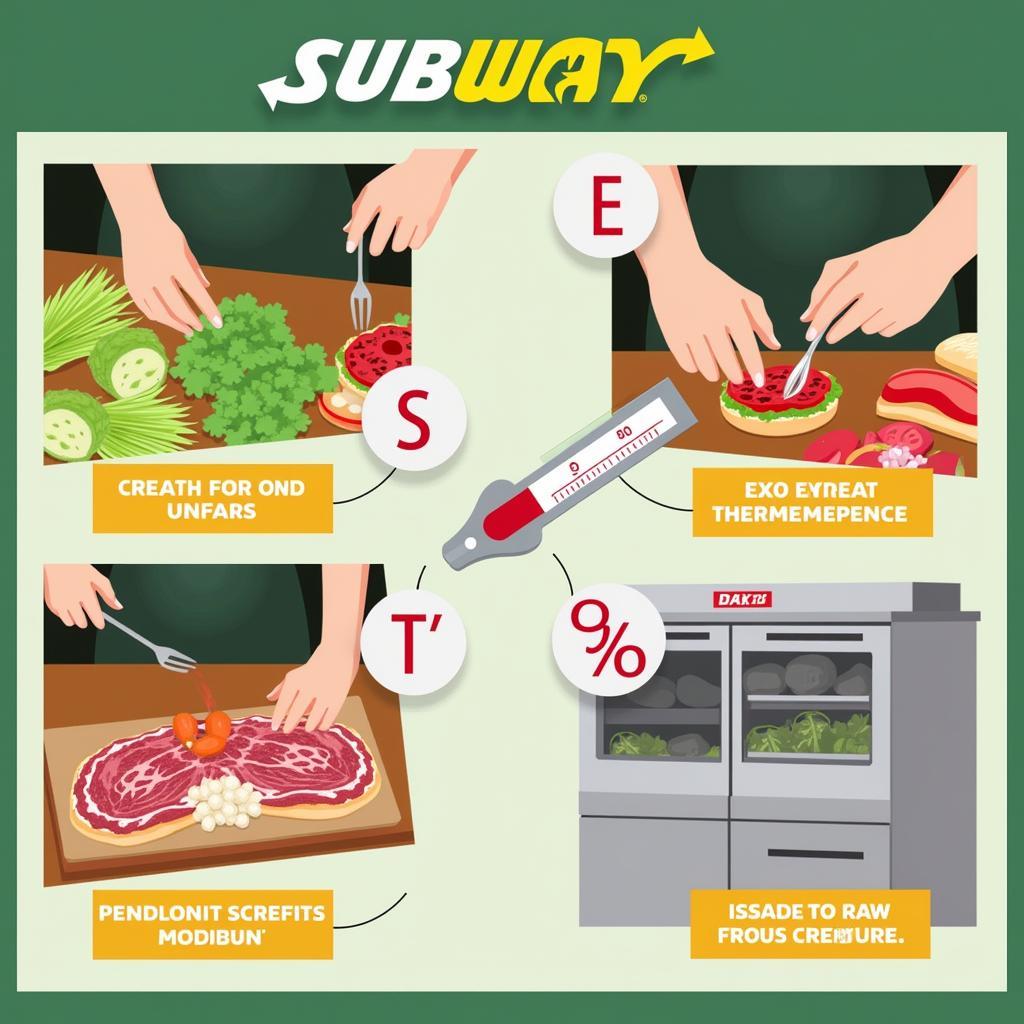Subway Food Poisoning is a serious concern for anyone who enjoys a quick and easy sub. While Subway strives to maintain food safety standards, outbreaks can still occur, leaving consumers with unpleasant and sometimes dangerous health consequences. This article dives deep into the topic of Subway food poisoning, exploring its causes, symptoms, prevention, and what to do if you suspect you’ve been affected.
Understanding the Risks of Subway Food Poisoning
Foodborne illnesses can originate from various sources, and fast-food chains like Subway are not immune. Several factors can contribute to contamination, including improper handling of ingredients, inadequate temperature control during storage and preparation, and cross-contamination between raw and cooked foods. Understanding these risks is the first step in protecting yourself.
Contaminated produce, such as lettuce, tomatoes, and spinach, can be a significant source of food poisoning. These ingredients are often handled by multiple people during processing and preparation, increasing the chances of bacterial contamination. Meat and poultry products, if not cooked to the proper internal temperature, can also harbor harmful bacteria.
 Potential Subway Food Contamination Sources
Potential Subway Food Contamination Sources
One of the most common culprits in food poisoning cases is E. coli, Salmonella, and Norovirus. These pathogens can cause a range of symptoms, from mild discomfort to severe illness requiring hospitalization.
How Does Contamination Occur at Subway?
Contamination can occur at various stages, from the farm where ingredients are grown to the final preparation of your sub. Even seemingly minor lapses in hygiene, such as an employee not washing their hands properly, can introduce harmful bacteria into the food chain.
Recognizing the Symptoms of Subway Food Poisoning
The symptoms of food poisoning can vary depending on the type of bacteria or virus involved. Common symptoms include nausea, vomiting, diarrhea, stomach cramps, and fever. These symptoms can appear within a few hours of consuming contaminated food or may take several days to manifest.
What are the Common Symptoms?
- Nausea and Vomiting: These are often the first signs of food poisoning and can range from mild to severe.
- Diarrhea: This can be watery or bloody, and its frequency can vary.
- Stomach Cramps: These can be sharp and debilitating, making it difficult to carry out daily activities.
- Fever: A fever may indicate a more serious infection.
If you experience any of these symptoms after eating at Subway, it’s essential to seek medical attention, especially if the symptoms are severe or persistent.
Preventing Subway Food Poisoning
While you can’t control everything that happens in a restaurant’s kitchen, there are steps you can take to minimize your risk of food poisoning.
Tips for Staying Safe
- Choose Fresh Ingredients: Opt for vegetables that appear crisp and vibrant. Avoid wilted or discolored produce.
- Ensure Proper Cooking Temperatures: If you’re ordering meat or poultry, ensure it’s thoroughly cooked.
- Practice Good Hygiene: Wash your hands thoroughly before and after eating.
What to Do If You Suspect Subway Food Poisoning
If you believe you’ve contracted food poisoning from Subway, it’s crucial to take the following steps:
- Seek Medical Attention: Consult a doctor, especially if your symptoms are severe.
- Report the Incident: Contact your local health department to report the suspected food poisoning.
- Document Your Experience: Keep a record of your symptoms, what you ate, and when you ate it.
 Reporting a Food Poisoning Incident
Reporting a Food Poisoning Incident
Conclusion
Subway food poisoning is a real risk, but by understanding the causes, symptoms, and preventive measures, you can significantly reduce your chances of becoming ill. Remember to always prioritize food safety and seek medical attention if you experience any symptoms of food poisoning after eating at Subway.
FAQ
- How common is Subway food poisoning? While outbreaks occur, they are not as frequent as one might think, thanks to food safety regulations.
- What are the long-term effects of food poisoning? Most cases resolve within a few days, but some can lead to long-term complications, such as irritable bowel syndrome.
- Can I sue Subway if I get food poisoning? Yes, it’s possible to pursue legal action, especially if you can prove negligence on the part of the restaurant.
- How can I prevent food poisoning at home? Practicing proper food handling and storage techniques is key to preventing food poisoning in your own kitchen.
- What is the best way to reheat Subway leftovers? Reheat your Subway sandwich to an internal temperature of 165°F (74°C) to ensure food safety.
- How long can I keep a Subway sandwich in the refrigerator? It’s best to consume your Subway sandwich within 24 hours of purchase.
- What are the signs of a severe foodborne illness? High fever, bloody diarrhea, and persistent vomiting are signs that you should seek immediate medical attention.
If you need any assistance please contact Phone Number: 02437655121, Email: [email protected] Or visit our address: 3PGH+8R9, ĐT70A, thôn Trung, Bắc Từ Liêm, Hà Nội, Việt Nam. We have a 24/7 customer service team.